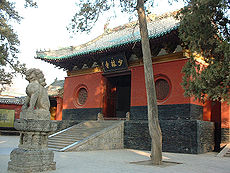- Qinggong
-
Part of the series on
Chinese martial artsList of Chinese martial arts Terms Historical places - Shaolin Monastery (少林寺)
- Wudang Mountains (武當山)
- Mount Hua (華山)
- Mount Emei (峨嵋山)
- Kunlun Mountains (崑崙山)
Historical people - Five Elders (五祖)
- Yim Wing-chun / Yan Yongchun (嚴詠春)
- Hung Hei-gun / Hong Xiguan (洪熙官)
- Fong Sai-yuk / Fang Shiyu (方世玉)
- Dong Haichuan (董海川)
- Yang Lu-ch'an (楊露禪)
- Wu Quanyou (吳全佑)
- Ten Tigers of Canton (廣東十虎)
- Chen Fake (陳發科)
- Chan Heung / Chen Xiang (陳享)
- Wong Fei-hung / Huang Feihong (黃飛鴻)
- Sun Lu-t'ang (孫祿堂)
- Huo Yuanjia (霍元甲)
- Yip Man / Ye Wen (葉問)
- Wang Zi-Ping (王子平)
- Bruce Lee / Li Xiaolong (李小龍)
- Jackie Chan / Cheng Long (成龍)
- Sammo Hung / Hong Jinbao (洪金寶)
- Yuen Biao / Yuán Biāo (元彪)
- Jet Li / Li Lian Jie (李連杰)
- Donnie Yen / Zhēn Zǐdān (甄子丹)
Legendary figures - Bodhidharma / Putidamo / Damo (菩提達摩)
- Zhang Sanfeng (張三丰)
- Eight immortals (八仙)
Related Qinggong (traditional Chinese: 輕功; simplified Chinese: 轻功; pinyin: qīnggōng; Wade–Giles: chin k'ung; Cantonese Yale: Hìng Gùng; literally "light body skill[1]") is a form of Chinese martial arts.
Its use has been exaggerated in Wuxia fiction, where martial artists (or pugilists) have the ability to move swiftly and lightly at superhuman speed, perform gravity-defying moves such as gliding on water surfaces, scaling high walls, mounting trees, appearing as though they can fly.[citation needed]
In some Wuxia / martial arts films containing elements of wire fu, Qinggong stunts are simulated by the actor or stuntman suspending himself from wires.[citation needed]
In traditional Baguazhang training, Qinggong is involved. The practitioner runs up a plank supported against a wall. The gradient of the plank is increased gradually over time as his training progresses.[2]
See also
References
- ^ Timofeevich, etc all; Andrew Timofeevich, Jin Yi Ming, Guo Cui Ya (2007). Lian Gong Mi Jue: Secret Methods of Acquiring External and Internal Mastery. Lulu.com. ISBN 184753371X. http://books.google.com/books?id=qAyq4PehB3oC&pg=PA8&dq=%22Qing+Gong%22&hl=en&ei=yAgWTM_cOcK88gbc5u2zCg&sa=X&oi=book_result&ct=result&resnum=4&ved=0CDwQ6AEwAzgK#v=onepage&q=%22Qing%20Gong%22&f=false.
- ^ Lutang, Cartmell,; Sun Lutang, Tim Cartmell (2003). A Study of Taijiquan. North Atlantic Books. p. 25. ISBN 1556434626. http://books.google.com/books?id=DVqGOf1WB9EC&pg=PA25&dq=%22Qing+Gong%22&hl=en&ei=_QgWTJL-F8OB8gbwmNSuCg&sa=X&oi=book_result&ct=result&resnum=2&ved=0CC4Q6AEwATgU#v=onepage&q=%22Qing%20Gong%22&f=false.
Categories:
Wikimedia Foundation. 2010.

